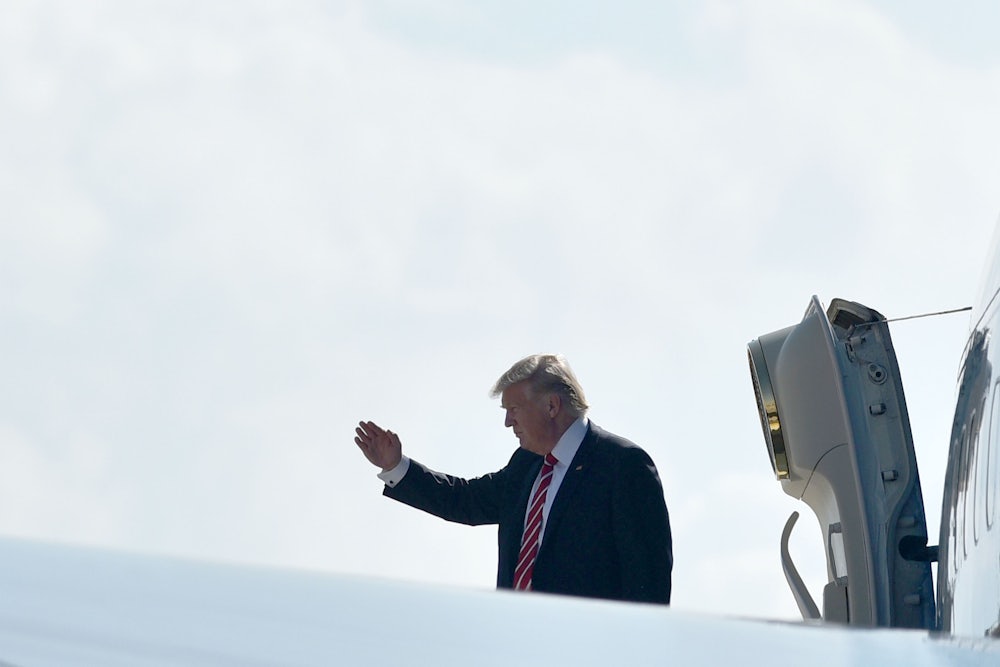The term “fake news” outlived its usefulness almost as soon as it became common parlance, and is perhaps only valuable now as a marker for whether journalism that paints President Donald Trump in an unflattering light has reached his desk. We know, for instance, that Trump isn’t fond of a growing body of reportage that confirms he is easily manipulated by clever underlings, including top adviser Steve Bannon.
I call my own shots, largely based on an accumulation of data, and everyone knows it. Some FAKE NEWS media, in order to marginalize, lies!
— Donald J. Trump (@realDonaldTrump) February 6, 2017
But Trump doesn’t dispute the legitimacy, accuracy, or integrity of countervailing institutions (like the media and the judiciary) or cumbersome obstacles (like the federal bureaucracy and civil society organizations) simply when his ego is bruised. Intentionally and otherwise, he does it to weaken their perceived authority and effectiveness so that he can exercise political power in a more unfettered way.
Two weeks into his presidency, Trump is exceedingly disliked and growing more so. His capacity to run the government with any competence has been questioned not just by supporters of the last administration, but by Karl Rove, “Morning” Joe Scarborough, anonymous GOP officials, and other natural allies. In a way, his administration enjoys continuity with his dark horse presidential campaign, which was similarly beset by incompetence, melodrama, and criticism.
Trump’s tendency to lash out at naysayers and rivals for dominance has been plain for years, but in politics, at least, he has always behaved this way in a siege-like environment. He has never been popular, and has always had rivals. That those rivals are now fixed institutions rather than campaign opponents is a source of hope that he will flail like a cornered rat until he gets devoured. But his assault on competitor institutions will take a major and perhaps fatal toll if at some point he becomes genuinely popular. From our current vantage point, that seems unlikely. But, of course, the story of the Trump era is a cascade of unlikely events piled on top of one another.
Trump’s critics at times get bogged down in debate over whether he’s acting methodically or just trying to land haymakers. But the question of intent is far less important than the questions of effect or aim.
When he calls mainstream media outlets purveyors of FAKE NEWS, he is drawing battle lines between his supporters and much more trustworthy sources of information. He has compared U.S. intelligence officials to Nazis, and then tried clumsily to lure them into a fight with the media; on Monday, he told U.S. Central Command that the American news media buries acts of terrorism, suggesting journalists and jihadis might share some underlying objectives against American national interests.
Trump frequently engineers these conflicts through a combination of inconsistency and dishonesty. Consider his support for a “Muslim ban,” which he has never disavowed. The proposal remains on his campaign website. Over time, as the outcry grew, he adopted the term “extreme vetting” to describe his position on Muslim travel and immigration, and he still becomes defensive when anyone calls his immigration policy a “Muslim ban” or reminds the public that he once called for a “total and complete shutdown of Muslims.” Design is beside the point: As far as many of his loyalists are concerned, anyone who accuses him of trying to ban Muslims is a political enemy—not a journalist, a lawyer, or a judge.
Perhaps because judges are the greatest impediments to autocratic rule, Trump has singled them out most insidiously. Having inflamed global tensions by antagonizing millions of Muslims in a legally dubious way, Trump not only seeks to attack those who accurately describe the steps he’s taken, but to set up anyone standing in his way for blame when the backlash occurs.
1. Fabricate a fake threat. 2. Address it in an illegal way that creates *real* treat. 3. Blame threat you created on courts upholding law.
— Will Wilkinson (@willwilkinson) February 5, 2017
Trump is courting terrorism to gain political power at the expense of his power rivals. He doesn’t need a masterplan or even a high level of consciousness about it for us to recognize that this is what’s happening.
In the absence of a major crisis, this has the effect of pitting his most committed supporters against a broad opposition: The significant majority of Americans, who find his political style unappealing, alarming, or grotesque. Trump cannot render the country’s massive democratic institutions impotent when most Americans will make common cause with them over him. If the attack Trump is courting comes, the ensuing battle for narrative control will determine whether he, or his opposition, is held responsible for it, and thus, how durable the resistance to authoritarianism will be. His opponents will have facts on their side, but he will have the largest bully pulpit and the means of retribution at his disposal. If at some point, without changing tactics, Trump wins over a broader swath of the public, the real damage to democracy will begin.
